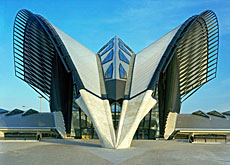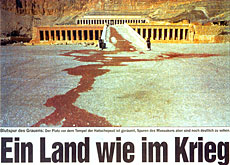Capturing beauty among the beasts

Swiss photographer Christian Helmle has spent seven years tracking the most impressive "white elephants" in the wilds of Europe.
He has not been hunting animals but buildings – projects that began with expectations but which have ended up being – like the proverbial white elephant – useless, troublesome or never used at all.
Helmle’s pictures are currently on show in the fine arts museum in Thun, near the capital, Bern, and have been published in a book.
But the safari has not always been easy. When the photographer drove through the Swiss Jura to the French region of Burgundy in 1999 it was so foggy that he was convinced he would not be able to take a picture of his destination – the disused Pagny river port in the Saône Valley. The result is one of the most beautiful pictures in the book.
swissinfo: What fascinates you so much about peeling facades, rusting scaffolding and crumbling ruins?
Christian Helmle: I wouldn’t have spent so many years on these objects if they did not have a certain appeal for me. They have an air of romance about them. What they all have in common is that they did not become what they were meant to be. I see these buildings as beings, which have a certain aura. That is what I find so fascinating.
swissinfo: What is the link between the Mystery Park in Interlaken with the little used Santiago Calatrava-designed station in Lyon or the never used Zwentendorf nuclear power plant near Vienna?
C.H.: They all bear witness to failed visions – but worthwhile photographic subjects. It’s certainly not about showing them as failures.
swissinfo: But resources, energy and money were wasted…
C.H.: Nevertheless the intentions for these buildings were often good at the beginning. They were innovative and testament to an entrepreneurial spirit. For this reason, I sometimes feel a bit sorry for them. I find it hard to see how they were never able to fully “bloom”.
swissinfo: And there can be a certain beauty in imperfection.
C.H.: There are buildings that look more beautiful with scaffolding than in their finished state with their plaster and ornate elegance. Scaffolding has something of a sculptural feel about it.
swissinfo: What is special about these stories which tell of ruined buildings or failed visions?
C.H.: When political forces, such as ministries, become involved, you notice that in all systems something of the original character remains. One example from the book is a Jewish department store in the Berlin-Mitte district, which was built in 1929. After this was expropriated, it became the headquarters of the Hitler Youth. From 1946 it was the party headquarters of the Socialist Unity Party of Germany (SED), and in 1959-95 it was used by the Institute for Marxism and Leninism. Since then it has been empty, but the spiritual structure remains.
swissinfo: Several of these German and French buildings are the results of megalomaniac-style bad planning. What is the situation in Switzerland?
C.H.: Switzerland works differently; it is smaller and more cautious. I have photographed two historical buildings in Switzerland… [one of which is] the Wetterhornbahn in Grindelwald, the oldest cable car in the world. It was built in around 1910, was in use for a few years and then the First World War came along and the project stalled after the first stage.
From the present day there is the Mystery Park, where the concept never really took off.
swissinfo: Are the buildings meant to look beautiful in the photos?
C.H.: Absolutely, that’s very important. I have always tried to see the buildings with a certain dignity. It’s not about showing how broken or tattered they are – not all of them are ruins. You can see important architecture from Aldo Rossi, Santiago Calatrava or Hans Kollhoff. Even when they are architecturally more mundane, they have a certain beauty.
swissinfo-interview: Susanne Schanda
The White Elephants exhibition – photographs by Christian Helmle, runs in the Thun fine arts museum from December 8, 2007 – January 13, 2008.
The book “White Elephants” (in German and English) with 60 images, has a foreword by art historian Konrad Tobler. It can be purchased from bookshops or from the author at foto@christianhelmle.ch.
This is defined as a possession that is useless and troublesome, especially one that is expensive to maintain and difficult to get rid of.
The story goes that the kings of Siam (nowadays Thailand) gave white elephants as a gift to courtiers they disliked, to ruin the recipient by the great expense of maintaining the animal.
(Source: Oxford Dictionary of English)
Christian Helmle was born in 1952 in Thun and has been working as a freelance photographer since 1982.
In addition to a national scholarship for his work, he has been awarded many photo prizes and bursaries in Cairo, Tunisia and Berlin.
He has exhibited both in Switzerland and abroad and has published several books.
Helmle has been working from his Thun workshop – a former manufacturing building of armaments and technology firm Ruag – for 3 years.

In compliance with the JTI standards
More: SWI swissinfo.ch certified by the Journalism Trust Initiative



You can find an overview of ongoing debates with our journalists here. Please join us!
If you want to start a conversation about a topic raised in this article or want to report factual errors, email us at english@swissinfo.ch.